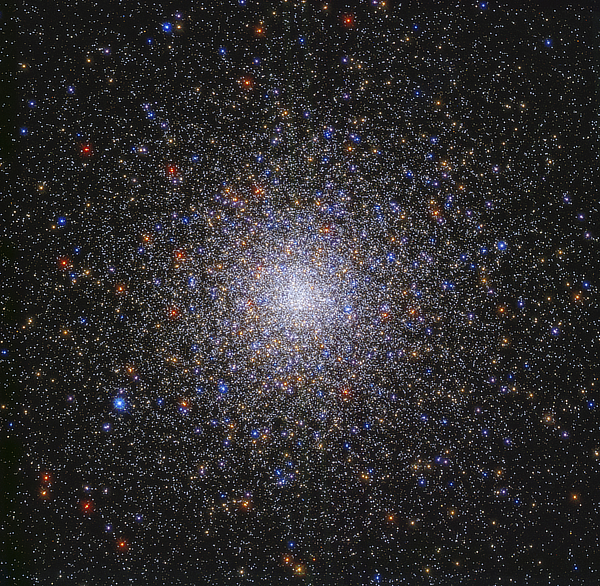Messier 4 and Messier 80 in Scorpius
May 2023 - Nebula and Cluster of the Month
Once more we must resort to the southern sky to provide us with material for this month. For May, we’re going to compare and contrast two globular clusters, both of which should be familiar even to northern hemisphere observers.
Both lie in the constellation Scorpius, only three degrees apart, and both are in Charles Messier’s list of objects to avoid whilst comet hunting.
The two globular clusters are Messier 4 and Messier 80. Fundamentally similar, but with interesting and illuminating differences.
M4 was discovered by Philippe Loys de Chéseaux (1718-1751) in 1746. He wrote, of his entry no 19, Close to Antares... it is white, round and smaller than the preceding ones. I do not think it has been found before.
Messier saw it on 8th May 1764, writing Cluster of very small stars: with an inferior telescope it appears more like a nebula; this cluster is situated near Antares and on the same parallel... diameter 2½’.

It is interesting to note that Messier could resolve this globular cluster into stars, despite the allegedly poor quality of his instruments. The brightest stars in M4 nearly reach tenth magnitude (with a proviso that I’ll come to later), making the task of resolution somewhat easier than normal.
M80 was discovered by Messier himself, on 4th January 1781. He described his discovery in these words: Nebula without star in the Scorpion, between the stars g [now called rho Ophiuchi] and delta; ... This nebula is round, the centre brilliant and it resembles the nucleus of a little comet, surrounded with nebulosity.
William Herschel, on observing M80 and the star field around it, wrote: An opening in the Heavens... This opening is at least 4° broad but its height I have not yet ascertained. It is remarkable that [M80], which is one of the richest and most compressed clusters of small stars I remember to have seen, is on the western border of it and would almost authorise a suspicion that the stars of which it is composed, were collected from that place and had left the vacancy.
A fascinating insight into his ever-theorising mind.

On paper, M4 is the larger and brighter of the two. It is magnitude 5.8 and has a diameter of about 30’ or so, the same size as the Moon in the sky. Needless to say, barely half of this diameter will actually be visible to an observer at the eyepiece. M80, on the other hand, is considerably fainter at magnitude 7.3 and covers just 10’ of sky, though again, barely half of this will be visible to a visual observer.
M4 is 5,500 light-years away (though estimates vary) and is the closest globular cluster to us. M80, on the other hand, is 32,600 light-years away – beyond the galactic centre (again, estimates vary).
On the face of it, then, M4 would seem to be the better bet. In his 1968 book Messier’s Nebulae and Star Clusters, Kenneth Glyn Jones writes: ...in the amateur’s telescope it [M4] appears large and bright and much more conspicuous than near-by M.80.
He clearly suffered from far less light pollution than most amateur astronomers today. I have seen M4 from a dark-sky site in Britain through 10x50 binoculars with no difficulty. However, from my home location I have never seen it at all. I can barely see Antares. I have, on the other hand, seen and made an observation of M80. The problem has two causes. Firstly, M4 is slightly lower in the sky than M80 (by about 3½°), but more importantly, M4 is a very loose globular, whilst M80 is one of the densest known. In the Shapley-Sawyer concentration classification system, M4 is a class IX object, whilst M80 is a class II. I have written before that the most important metric in determining the visibility of a globular cluster is its concentration, and this is a prime example.
There is a chain of stars that passes North-South across the centre of M4. These stars are mostly 11th and 12th magnitude, but the brightest is magnitude 10.6. This feature is sometimes referred to as a ‘bar’. It was first noted by William Herschel and can be seen with modest telescopes quite easily, given a good enough sky. This will be what Charles Messier saw back in 1764. The Deep-Sky Field Guide to Uranometria 2000.0 gives the brightest star magnitude for M4 as 10.8 – the star I mentioned before. Archinal & Hynes’ Star Clusters, however, gives the magnitude of the brightest star as 13.4. It would seem, then, that the ‘bar’ is considered (at least by them) to be in the foreground and not part of the globular cluster itself.

I’ve included my observation of M80. It isn’t exciting, but I was pleased to get it. I have observed objects – even a few globular clusters – more southerly than M80 (M30, M22, M79, M28), but it seems that my line of total invisibility lies somewhere between M28 (-24° 52’) and M4 (-26° 32’).
| Object | RA | Dec | Type | Magnitude |
|---|---|---|---|---|
| Messier 4 | 16h 23m 35s | -26° 31’ 34” | Globular cluster | 5.8 |
| Messier 80 | 16h 17m 03s | -22° 58’ 29” | Globular cluster | 7.3 |